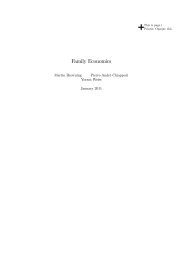Bounded Rationality in Industrial Organization
Bounded Rationality in Industrial Organization
Bounded Rationality in Industrial Organization
You also want an ePaper? Increase the reach of your titles
YUMPU automatically turns print PDFs into web optimized ePapers that Google loves.
oundedly rational counterpart. Next year is the 50th anniversary of Strotz’s (1956) sem<strong>in</strong>al<br />
work on time <strong>in</strong>consistency. The rule-of-thumb approach is even older. The application of<br />
these ideas to <strong>in</strong>dustrial organization has waxed and waned, but by now it amounts to a<br />
substantial literature.<br />
I beg<strong>in</strong> this essay with a discussion of several old literatures. I do this both because<br />
I th<strong>in</strong>k it is useful to recount what happened before 1990, and because it provides an<br />
opportunity to expla<strong>in</strong> what the different boundedly rational approaches are, what are<br />
their strengths and weaknesses, and where they have been most successful. I th<strong>in</strong>k all<br />
three methodologies are useful and that anyone <strong>in</strong>terested <strong>in</strong> boundedly rational <strong>in</strong>dustrial<br />
organization should be fluent with each of them.<br />
I then turn to the more recent literature on boundedly rational IO. Here, I see the literature<br />
as hav<strong>in</strong>g divided <strong>in</strong>to two ma<strong>in</strong> branches. The first is grow<strong>in</strong>g out of the <strong>in</strong>dustrial<br />
organization literature. Papers <strong>in</strong> this branch typically beg<strong>in</strong> with one of two observations:<br />
the IO literature on some topic is unsatisfy<strong>in</strong>g because aspects of the exist<strong>in</strong>g rational models<br />
aren’t compell<strong>in</strong>g; or the IO literature has had little to say about some topic (perhaps<br />
because rational model<strong>in</strong>g would have been awkward). They then propose models with<br />
some boundedly rational elements and discuss how they add to the literature on the topic.<br />
The second branch is grow<strong>in</strong>g out of the psychology and economics literature. Papers <strong>in</strong> this<br />
branch typically start by not<strong>in</strong>g that the psychology and economics literature has shown<br />
that consumers depart from rationality <strong>in</strong> some particular way. They then explore how a<br />
monopolist would exploit such a bias, what the effects would be under competition, etc. I<br />
provide overviews of each of these literatures and discuss some general themes.<br />
Readers of this survey will note that the literatures I discuss rema<strong>in</strong> sparse. Most<br />
topics <strong>in</strong> IO have little or no boundedly rational work on them. Most behavioral biases<br />
have received little or no consideration <strong>in</strong> IO, and even when they have been discussed it<br />
is only the most basic IO questions that have been asked. This makes it an excit<strong>in</strong>g time<br />
to work <strong>in</strong> the field.<br />
2













